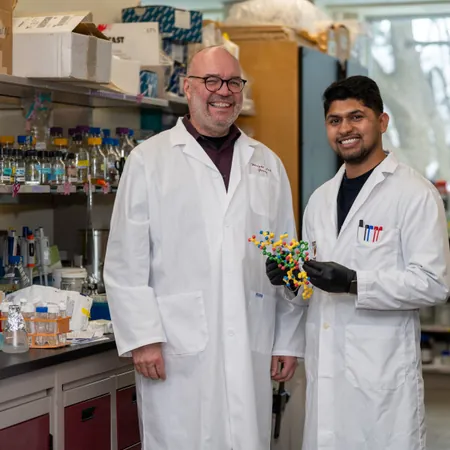
Groundbreaking Antibiotic Discovery: McMaster University Unveils a Game-Changer in the Fight Against Drug-Resistant Bacteria
2025-03-26
Author: Arjun
In a remarkable breakthrough that could reshape the future of medicine, researchers at McMaster University in Hamilton, Ontario have discovered a brand-new class of antibiotics, marking the first such finding in almost thirty years. This revolutionary antibiotic, known as lariocidin, shows promise in effectively combating some of the most resistant bacteria threatening public health today.
The research team, spearheaded by Professor Gerry Wright from the Department of Biochemistry and Biomedical Sciences, published their findings in the prestigious journal Nature on March 26, 2025. This discovery addresses an urgent global challenge: antimicrobial resistance, recognized by the World Health Organization as one of the predominant public health threats of our time. An alarming 4.5 million people succumb to antibiotic-resistant infections each year, and the situation is expected to escalate if new solutions aren’t found.
"Our existing antibiotics are increasingly ineffective against evolving bacterial strains," Professor Wright stated. "Lariocidin could potentially change that narrative."
The unique lasso peptide structure of lariocidin sets it apart from other antibiotics. This new molecule exhibits a different mode of action by directly binding to the bacterial protein synthesis machinery, inhibiting their growth in unprecedented ways. This novel mode makes it a potent candidate for further clinical development.
Lariocidin's source is equally fascinating. The compound was isolated from Paenibacillus, a bacteria discovered in a soil sample from a backyard in Hamilton. After cultivating the bacteria for one year, the research team was able to observe its growth and identify the production of lariocidin, which demonstrated strong efficacy against notorious antibiotic-resistant bacteria.
Dr. Manoj Jangra, a postdoctoral fellow in Wright's lab, recounted the excitement of the discovery. "When we identified how this new molecule effectively kills other bacteria, it was a breakthrough moment for our team," he said.
Initial tests indicate that lariocidin is non-toxic to human cells, evades existing antibiotic resistance mechanisms, and proves effective in animal infection models. These key attributes make it a formidable candidate for future drug development.
However, despite the thrilling breakthrough, Professor Wright cautioned about the long road ahead. "While this initial discovery was astonishing, the true challenge lies in modifying the molecule and producing it in sufficient quantities for clinical use," he explained.
The urgency of this discovery cannot be overstated, given the grim statistics surrounding antibiotic resistance. The medical community is eagerly awaiting advancements in lariocidin’s development, hoping this new antibiotic will play a vital role in restoring the efficacy of treatment against resistant infections.
With lariocidin at the forefront, the future of antibiotics and the fight against drug resistance may finally be brightening—an exciting prospect that could save countless lives in the years to come.


 Brasil (PT)
Brasil (PT)
 Canada (EN)
Canada (EN)
 Chile (ES)
Chile (ES)
 Česko (CS)
Česko (CS)
 대한민국 (KO)
대한민국 (KO)
 España (ES)
España (ES)
 France (FR)
France (FR)
 Hong Kong (EN)
Hong Kong (EN)
 Italia (IT)
Italia (IT)
 日本 (JA)
日本 (JA)
 Magyarország (HU)
Magyarország (HU)
 Norge (NO)
Norge (NO)
 Polska (PL)
Polska (PL)
 Schweiz (DE)
Schweiz (DE)
 Singapore (EN)
Singapore (EN)
 Sverige (SV)
Sverige (SV)
 Suomi (FI)
Suomi (FI)
 Türkiye (TR)
Türkiye (TR)
 الإمارات العربية المتحدة (AR)
الإمارات العربية المتحدة (AR)